The Charging Bull, often referred to as the Bull Of Wall Street, stands as a globally recognized emblem of the American stock market and the dynamism of big business. This bronze sculpture is not just a landmark in New York City; it’s a pilgrimage site for tourists worldwide, eager to capture its powerful presence through photographs and poses.
Yet, for many visitors, the captivating story behind this iconic statue remains untold. As your guide to the essence of Wall Street, let’s delve into the origins of the Charging Bull, tracing its journey to its current prominent location and uncovering the layers of meaning it embodies.
Here’s everything you need to know about the Bull of Wall Street, ensuring you experience its full impact during your visit to NYC.
The Genesis of the Bull of Wall Street: An Artist’s Bold Vision
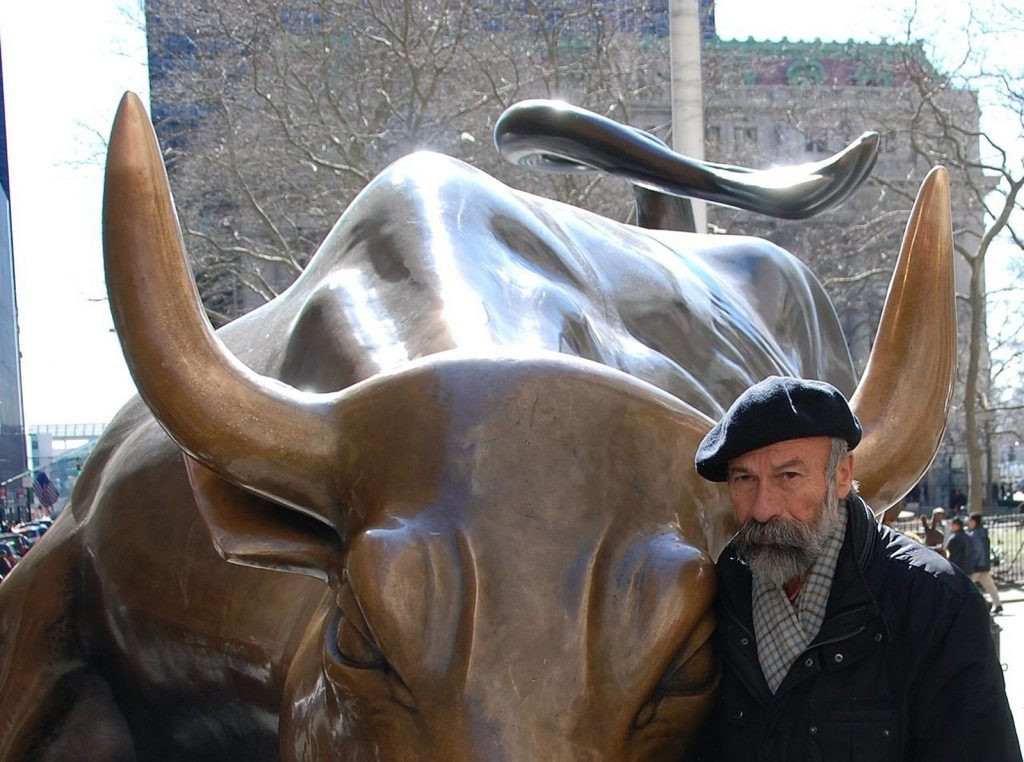 Arturo Di Modica with Charging Bull
Arturo Di Modica with Charging Bull
Behind the imposing figure of the Charging Bull, also affectionately known as the Wall Street Bull, lies a quintessential New York City narrative of ambition and artistic expression.
Arturo Di Modica, the Italian-American sculptor who conceived the Bull of Wall Street, was born in Sicily in 1941. His passion for sculpting ignited in his teenage years, leading him to Florence, where he garnered recognition throughout Italy for his artistic talent. Like many artists captivated by its vibrant energy, Di Modica journeyed to New York in the 1970s, establishing his studio on Grand Street in what is now the trendy SoHo district.
The inspiration for the Bull of Wall Street emerged in the aftermath of the devastating 1987 stock market crash. Di Modica felt a deep sense of gratitude towards America for embracing him and fostering his career as a sculptor. He envisioned the bull as a symbol of resilience, a tribute to the unwavering spirit of American business professionals navigating challenging economic times.
Investing $360,000 of his own funds, Di Modica brought the Charging Bull to life. His intention was to instill hope and encourage perseverance, embodying the “bull market” – a symbol of economic prosperity and the collective aspiration for financial recovery after the market downturn.
The Unveiling on Wall Street: A Guerilla Art Installation
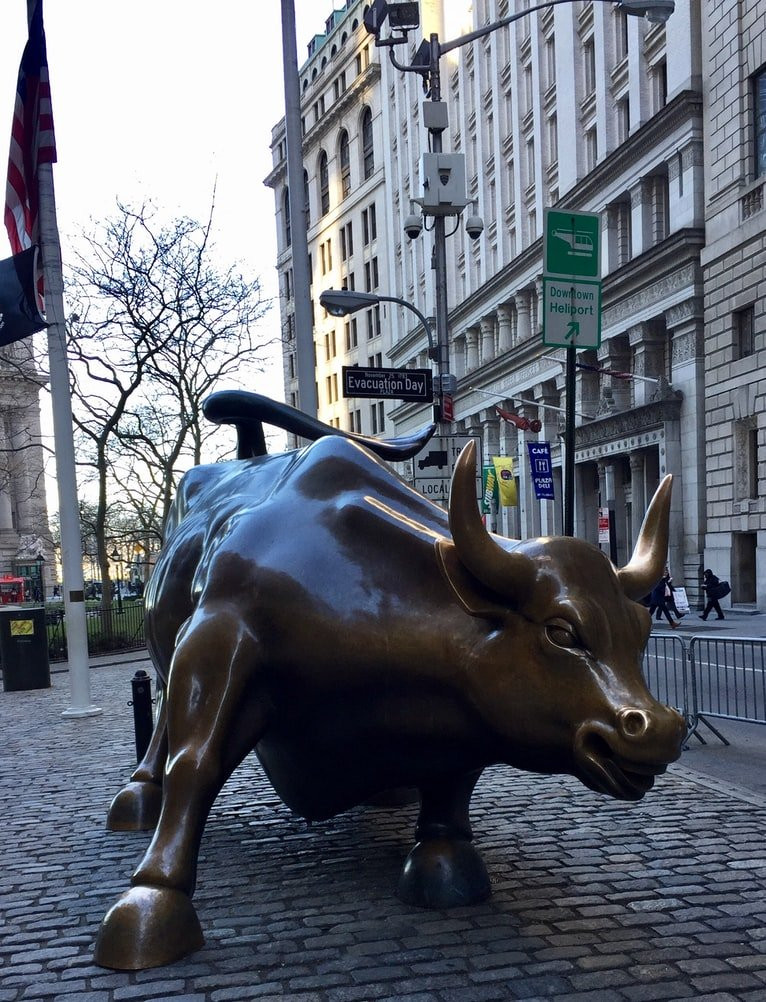 Charging Bull
Charging Bull
Weighing over 7,000 pounds and standing tall at 11 feet, the Bull of Wall Street was a monumental creation. In a daring act of guerilla art, Di Modica transported his massive sculpture into Lower Manhattan on a flatbed truck and, without permission, positioned it in front of the iconic New York Stock Exchange.
The date was December 15, 1989, during the peak of the festive holiday season. Di Modica envisioned the Bull of Wall Street as a symbolic Christmas gift to New Yorkers, a beacon of optimism placed beneath the towering Christmas tree on Broad Street.
However, this gesture of goodwill was not immediately embraced by the New York Stock Exchange authorities. Despite its intended symbolism of prosperity, the uninvited artwork led to the intervention of the police department. Later that day, the Charging Bull was removed and impounded.
Despite its brief initial presence on Wall Street, the public’s reaction was overwhelmingly positive. New Yorkers rallied for the bull’s return, captivated by its powerful symbolism and artistic merit. Responding to public demand, the New York City Department of Parks and Recreation intervened, relocating the statue just two blocks from the New York Stock Exchange. On December 21, 1989, the Charging Bull was officially rededicated in its new, and now permanent, home.
Fun fact: In 2004, Di Modica offered the Bull of Wall Street for sale, stipulating that it must never be moved from its location. To this day, it remains unsold, and Di Modica’s estate retains the copyright to this globally recognized artwork.
Locating the Bull of Wall Street: Your Guide to the Financial District
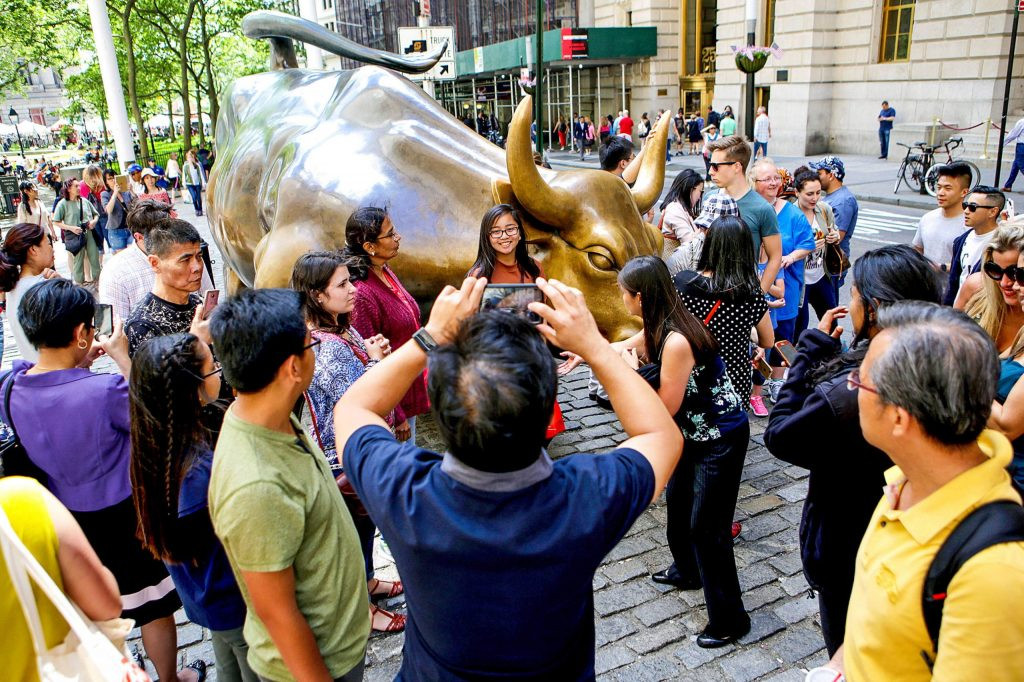 Tourists standing around the Charging Bull
Tourists standing around the Charging Bull
You can encounter the Bull of Wall Street in the heart of New York City’s Financial District. It proudly stands just north of Bowling Green Park, situated on Broadway, right below its intersection with Morris Street.
The Bull of Wall Street is positioned within a small cobblestone plaza. Be mindful of the bustling streets bordering the plaza and exercise caution when navigating the area.
While the statue is undoubtedly a highlight of Wall Street, the Financial District offers a wealth of attractions. Consider exploring these nearby landmarks during your visit:
- Battery Park: Offering stunning waterfront views and access to ferries to the Statue of Liberty and Ellis Island.
- Statue of Liberty & Ellis Island: Iconic symbols of freedom and immigration, accessible by ferry from Battery Park.
Timing Your Visit to the Bull of Wall Street: Avoiding the Crowds
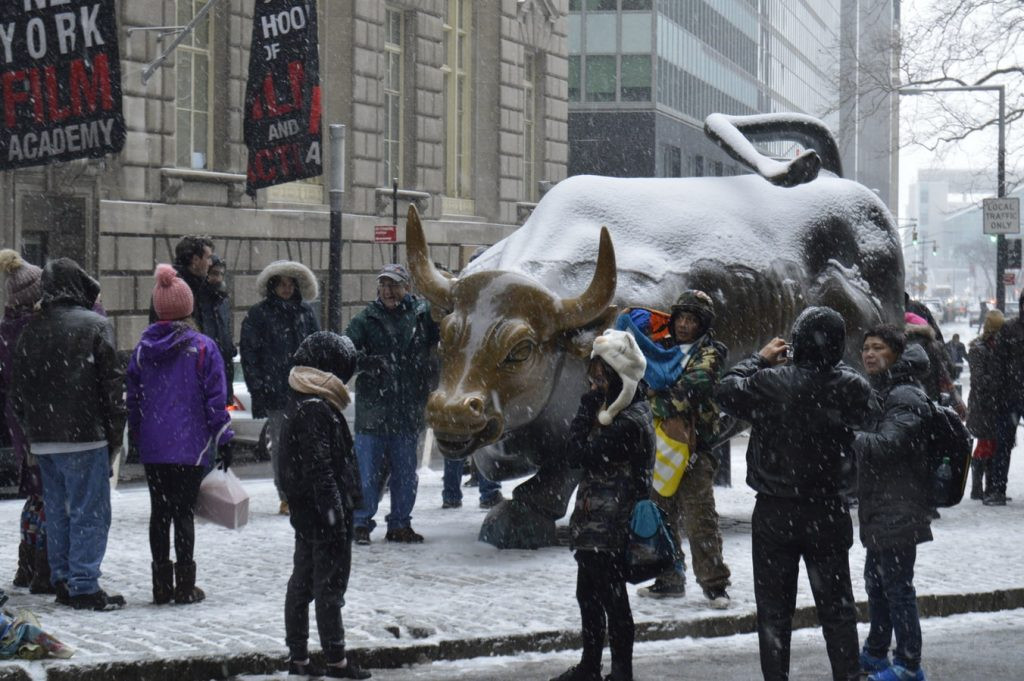 Charging Bull with snow
Charging Bull with snow
Unlike some of New York City’s ticketed monuments, such as the Statue of Liberty, visiting the Bull of Wall Street is free and accessible at any time. Its open street location makes it a popular destination, often drawing large crowds and queues of up to 30 minutes for a photo opportunity, particularly during peak tourist hours.
To experience the Bull of Wall Street with fewer crowds, aim for an early morning visit. Between 7 and 8 a.m., you’re likely to find a much more serene atmosphere. Alternatively, visiting after 6 p.m. can also offer a less congested experience, although daylight may be limited depending on the season.
Local Tip: Winter can be an opportune time to visit the Bull of Wall Street. Crowds tend to be thinner, excluding the immediate holiday period. You might even be rewarded with the unique sight of the bull adorned with a dusting of snow.
Experiencing the Bull of Wall Street: Beyond the Snapshot
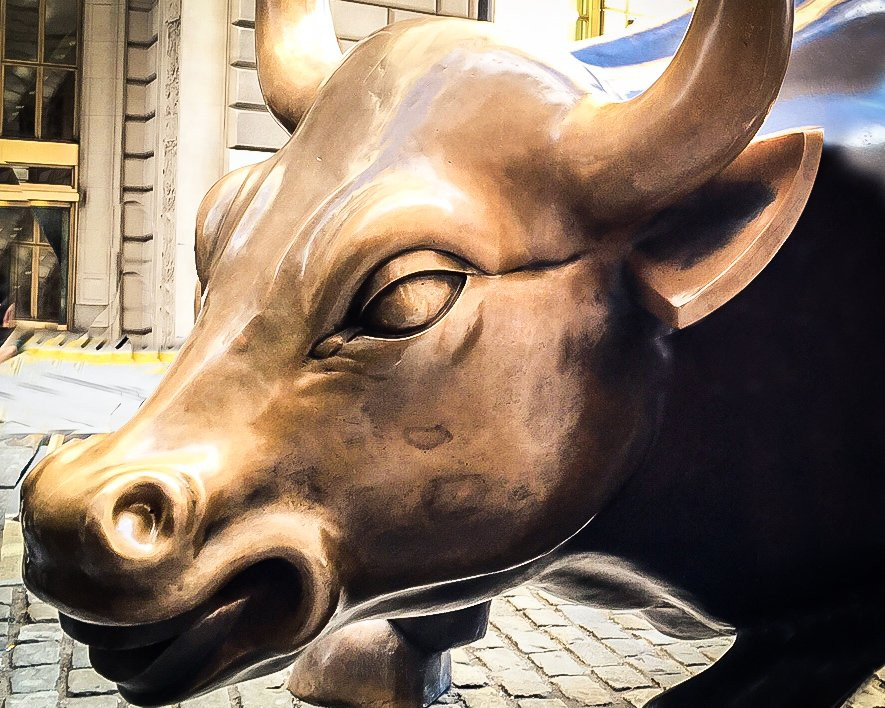 Face of the charging bull
Face of the charging bull
While capturing a photo with the Bull of Wall Street is a must for many, we encourage you to immerse yourself in the broader context of the Financial District to truly appreciate its significance.
Enhance your visit by joining one of our guided tours of Lower Manhattan. Discover the rich 400-year history that shaped Wall Street, from its humble beginnings as a Dutch trading post to its current status as a global financial powerhouse.
Our tours will take you through the financial institutions that have influenced not only the American economy but also the global financial landscape. Experience a journey through history, commerce, and art, culminating in an encounter with Di Modica’s iconic Bull of Wall Street sculpture.
Here’s a glimpse of a typical tour itinerary:
- New York Stock Exchange: Witness the heart of global finance.
- Wall Street: Walk the famed street and absorb its historical significance.
- Federal Hall: Explore the site of George Washington’s inauguration.
- Stone Street: Discover a charming cobblestone street with historical pubs and restaurants.
- Charging Bull: Encounter the symbol of Wall Street’s ambition.
- Trinity Church: Visit a historic church with connections to Alexander Hamilton.
- Federal Reserve Bank of New York: Learn about the central bank’s role in the US economy.
As you can see, the Bull of Wall Street is strategically positioned within a tapestry of historical and financial landmarks. It’s more than just a piece of art; it’s a potent symbol of the forces that have shaped Wall Street. Our acclaimed tour guides are ready to share deeper insights and answer all your questions about Wall Street, providing a richer understanding of this iconic landmark.
The Bull of Wall Street and the Fearless Girl: A Modern Dialogue
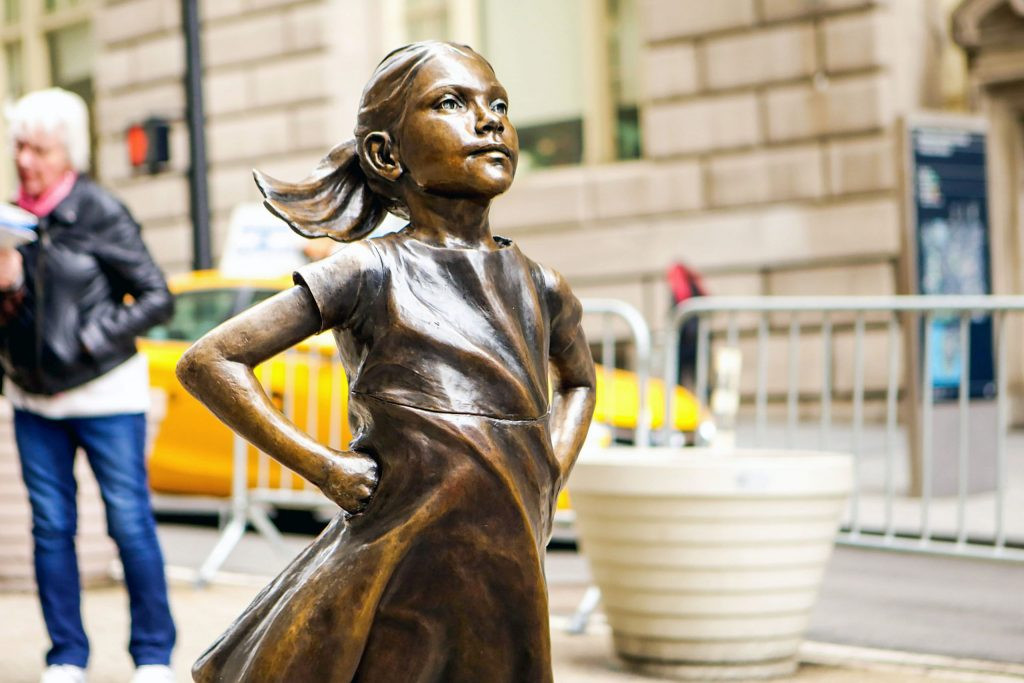 Fearless Girl
Fearless Girl
The Bull of Wall Street gained renewed attention when Kristen Visbal’s “Fearless Girl” statue was strategically placed facing it. This installation, unveiled on March 7, 2017, to commemorate International Women’s Day, became an instant sensation, much like the bull itself upon its initial appearance.
“Fearless Girl” was conceived to champion female empowerment and advocate for greater gender diversity in corporate leadership. The powerful image of a young girl confidently confronting the Bull of Wall Street resonated deeply, sparking petitions to make her presence permanent within just 48 hours of her arrival.
Initially granted a 30-day permit, “Fearless Girl” received extensions, remaining for nearly a year. However, Di Modica expressed his disapproval of her placement, leading to a dialogue with city officials. Ultimately, a compromise was reached, and in December 2018, “Fearless Girl” was relocated to face the New York Stock Exchange, continuing her symbolic stance against financial power structures.
Guide Tip: Visit the original location of “Fearless Girl” and discover a marker with small footprints, inviting you to stand in her place and gaze directly at the Bull of Wall Street, experiencing the dynamic tension between these two powerful sculptures.
The Enduring Allure of the Bull of Wall Street
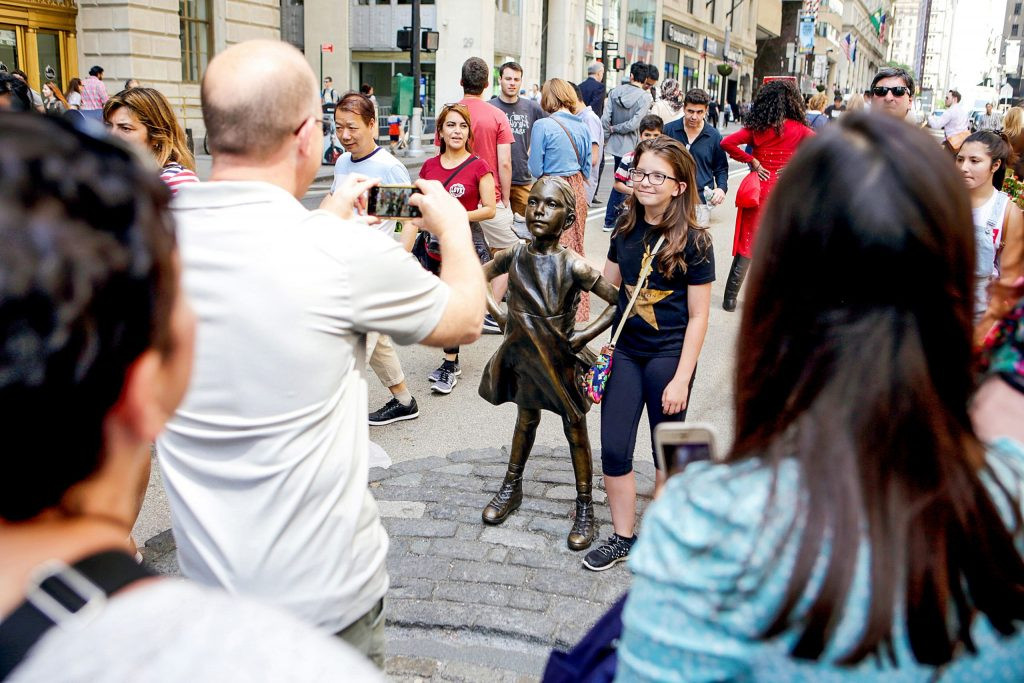 Taking pictures with the Fearless Girl
Taking pictures with the Fearless Girl
The Bull of Wall Street’s journey has been anything but ordinary, from its clandestine installation to its accidental rise to global fame.
Today, many visitors may not be fully aware of the historical context or the deeper symbolism behind the statue. Yet, seeing the Bull of Wall Street remains a quintessential New York City experience, a must-do on countless travel itineraries. As the story unfolds, it becomes clear how perfectly the bull embodies the spirit of the Financial District and the relentless energy of New York City.
Over three decades later, the Bull of Wall Street endures as an iconic symbol. Reflecting the resilience and ambition of the city and the business world it represents, the Bull of Wall Street stands firm and proud, ready to inspire for generations to come.
Eager to explore more of the Financial District? Discover our guide to Stone Street, another highlight on our immersive Wall Street tour.
